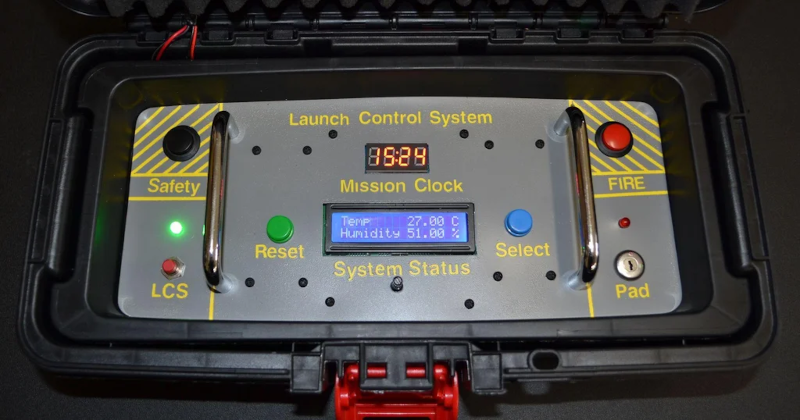It looks like an ordinary toolbox, but when you open up the Arduino Launch Control System, you’ll find a safe method for triggering model rocket launches. The system uses two separate power supplies. Both must be on for a successful launch and one requires a key. To trigger a 10-second countdown, the operator must hold down two buttons. Releasing either button will stop the countdown.
Besides safety, the controller tracks mission elapsed time and can read weather information from a few sensors. A good-looking build and we like the idea of building inside a toolbox for this sort of thing.
Towards the end of the post, there are some ideas for improving the build, like using a consolidated weather sensor, using a larger screen, and a bigger, more capable controller. It seems like more I/O would be useful,
Model rocketry isn’t as rigorous as launching a crew, but there were a few things that could improve the overall system safety. For example, the launch buttons could provide both normally open and normally closed contacts to guard against switch failure. In other words, if you see both inputs from one switch on or off for more than a tiny moment during switching, you can assume the switch has failed and put the system in a fail-safe mode. Of course, a switch failure in the off position isn’t a hazard, just an inconvenience. But a switch failure in the active position could allow an inadvertent launch. Granted, it would require something jamming the remaining switch for the entire 10-second countdown, but still. Arduinos are pretty reliable, but for a real rocket system, you’d probably have redundancy, and the software would do periodic checks to guard against things like memory corruption. For example, NASA has a relatively succinct list of requirements. But some of this is overkill for a model rocket launcher.
We’ve seen many takes on this kind of project. Of course, like everything else these days, you can just use your smartphone.















I am using this product
https://www.projehocam.com/urun/arduino-uno-r3-klon-usb-chip-ch340/
I applaud WCH for recognizing the niche that opened up in the wake of the FTDI debacle. ‘Course, for all I know, it was WCH that was producing the counterfeits that FTDI was fighting. The part I never understood is why Windows needed drivers to be supplied for a completely generic USB serial device.
To me an ordinary toolbox is made of metal, not that blow molded plastic stuff that is only fit to hold chocolates not sockets.
At least it doesn’t have a “lifetime hinge” but one drop on the corner and the lid comes off or the latches fail completely.
Okay, old man, I was just getting my ball. What’s so special about your lawn, anyway? Sheesh.
I really like that you used an inexpensive plastic tool box as a project box. A lot of bang for the buck. : )
Yes, I understand that this is a hobby launcher, not meant for high energy launches. BUT, with all the interlocks the designer appears to have built into his device, there is no mention of actual fail-safes. What is there to protect the user and people on the range from a microcontroller glitch that just sends a fire signal as soon as it powers up, or a short anywhere in the circuitry? That is, a failure on the part of the hardware rather than the user? The illusion of fail-safes can cause people to act with less caution, trusting the machines more than safe procedures.
Hi folks. I’m the builder of the Arduino Launch Control System and one thing you should probably be aware of is this is what happens when a 61 year old man gets an Arduino Starter Kit from his wife for his birthday. This is the very first project I ever made that wasn’t from the Starter Kit tutorials, with less than 6 months of playing around with it. I literally knew nothing about electronics prior to this. I knew enough to turn the power off before changing a socket, and when installing a car radio a fuse is your friend. But how a relay worked, what a resistor was, or any number of other things electronic I was completely in the dark.
Since then I have really enjoyed learning about this new aspect to my hobby of model rocketry. And I have a bunch of projects I want to build down the road. And with each new build I learn a lot. That’s the biggest reason I posted the build to Instructables. I was hoping that other folks who are new like me just might realize that this is something you really can do.
Now, I just need a rocket to launch?